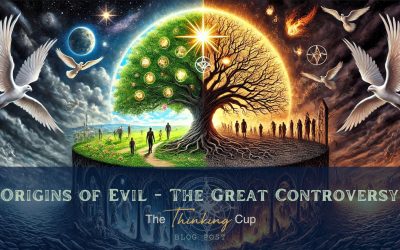Framing Inspiration to Deal with what is in the text
Let’s begin our discussion on inspiration by framing it as a process with two key participants. First, there’s God, who is the ultimate source of the biblical texts. Then, there’s the human author, who serves as the immediate source—the one who physically writes the words.
When I talk about God’s role, you’ll often hear me mention providence and guidance. By this, I mean that God’s involvement in inspiration includes preparing the human author for the moment when they need to write something down. This could happen through a direct prompting by the Spirit or through specific circumstances that led the author to write, whether or not they were aware that they were being divinely guided for a greater purpose. God knew what He wanted to be recorded and prepared individuals for these moments to ensure that His will was accomplished. So, while God provides the guidance and oversight, the human author serves as the immediate source of the text.
I stress this distinction because common misconceptions about inspiration can cause confusion, especially when we delve into the Bible’s origins and the processes involved in its creation. This also affects how we see other authors as being ‘inspired’ and what we do with their writings regarding our own understanding of the Biblical text.
Flawed Conception of Inspiration
There’s a common misconception that treats inspiration as a mystical or paranormal event. Some people imagine that biblical writers entered a trance-like state or engaged in automatic writing, where their minds were essentially shut off and were merely channels for divine words. This idea is a kind of paranormal view of how the biblical texts were initially written.
Part of the issue with this view is that it treats inspiration as a singular event rather than a process. There’s this notion that God somehow “zapped” the biblical author into a trance-like state, and when they came out of it, they were surprised by what they had written, as if they had no involvement in the process. This idea implies that the human mind and circumstances played little to no role in inspiration. It also suggests that the text produced by this “zapping” is untouchable and perfect from when it was written. However, this doesn’t align with how biblical books were created in the ancient world. It also implies that God’s interest in the text ceased once the prophet was “zapped” and wrote something down. These flawed ideas don’t match what we see in the biblical text.
Another flawed conception is the idea that inspiration works like science fiction. This view suggests that when God “zapped” the prophet, He gave them information far beyond their understanding or that of their audience, meant only for us in the modern era. But this doesn’t make sense, either. The whole point of inspiration was to communicate effectively. If the prophet and their audience couldn’t understand the message, it would defeat the purpose of communication.
The paranormal view of inspiration doesn’t align with what we see in the biblical text. There are clear signs of editing, and some biblical books show evidence of being composed in stages. The authors had specific goals and purposes, which shaped how they arranged material, what they included or left out, and how they used sources. These processes are part of what it means for a writer to be inspired—they were deliberate and thoughtful, not simply passive conduits for divine dictation.
A Coherent and Proper Conception of Inspiration
If I’m going to critique a certain understanding of inspiration as flawed, it’s important to offer a clearer, more coherent perspective in its place. A more accurate view of inspiration should be based on what we observe in the biblical text rather than on assumptions about how inspiration might have worked. To do this, we need to examine relevant biblical passages closely and interpret them in light of what the text actually shows.
The Origin of Scripture
One key passage is 2 Timothy 3:16-17, which states,
“All Scripture is breathed out by God (or inspired) and profitable for teaching, for reproof, for correction, and for training in righteousness, that the man of God may be complete, equipped for every good work.”
When Paul wrote this, he specifically referred to the Old Testament. This verse tells us that God is the ultimate source or origin of the Scriptures. However, it doesn’t give us details about the process of inspiration—how the Scriptures were actually written.
The Process of Inspiration
To understand the process, we can look at 2 Peter 1:20-21, which says,
“Knowing this first of all, that no prophecy of Scripture comes from someone’s own interpretation. For no prophecy was ever produced by the will of man, but men spoke from God as they were carried along by the Holy Spirit.”
Here, Peter explains that prophecy, which in this context refers to inspired utterances that were later written down, doesn’t originate solely from human effort. God plays a key role. This passage highlights that inspiration involves both divine and human participation. We can’t reduce inspiration to just God’s or man’s role alone.
However, this doesn’t mean that the process was one of dictation, where God took over the prophet’s mind and dictated every word while the prophet’s own thoughts and personality were disengaged. Instead, inspiration was a process where God provided guidance and oversight while the human author actively wrote.
Two Roles in Inspiration
So, we see that there are two roles in inspiration: God’s role and the human role. God providentially guided and shaped the biblical writers to carry out their tasks. The human role was to write down these ideas coherently and faithfully. Jeremiah 25:13 supports this idea, where God says,
“I will bring upon that land all the words that I have pronounced against it, all that is written in this book, which Jeremiah prophesied against all the nations.”
Here, we see that while prophets are typically viewed as God’s spokespeople, they also wrote for God. What they wrote was considered God’s word, even though God was working in the background as the ultimate origin, while the prophet was the immediate source.
In essence, inspiration is a collaborative process where both divine guidance and human effort come together to produce Scripture.
Understanding Inspiration Beyond Dictation
It’s crucial to discuss inspiration in a way that moves us away from the idea of dictation or the notion that God overtook a human’s mind and “downloaded” information to them. To illustrate why this is important, let’s look at some examples from the biblical text that show how a dictation model or a trancelike state fails to explain how these texts were written. The way the text itself behaves should guide our understanding of inspiration.
Take Ezekiel 1, for example. In the opening verses, we read:
“In the thirtieth year, in the fourth month, on the fifth day of the month, as I was among the exiles by the Chebar canal, the heavens were opened, and I saw visions of God. On the fifth day of the month (it was the fifth year of the exile of King Jehoiachin), the word of the Lord came to Ezekiel the priest, the son of Buzi, in the land of the Chaldeans by the Chebar canal, and the hand of the Lord was upon him there.” (Eze 1:1–3)
Notice how the text starts with the first person: “I was among the exiles… I saw visions of God.” But then it suddenly shifts to the third person: “The word of the Lord came to Ezekiel.” If Ezekiel himself was writing this, why wouldn’t he continue with, “The word of the Lord came to me”? This shift suggests the involvement of another person—an editor—who added or adjusted the text. This kind of editorial activity, where different perspectives appear within the same passage, strongly suggests that inspiration is more complex than simple dictation.
If inspiration were purely a matter of God dictating words directly to a prophet, this sort of textual phenomenon wouldn’t make sense. Instead, it points to a process that involves both divine inspiration and human contribution, including editing.
The Inscription on the Cross
Let me give you another example to emphasize why our understanding of inspiration should be shaped by the way the text itself is presented. This time, let’s look at an example from the New Testament, specifically from the Synoptic Gospels—Matthew, Mark, and Luke. This example is particularly straightforward, but similar patterns can be found in the Old Testament, especially in the books of Samuel, Kings, and Chronicles.
When we read the Synoptic Gospels, we notice that while they cover many of the same events, how they describe them often varies. They are recounting the same stories, but their wording differs. This becomes even more noticeable when we examine the original Greek text, where the vocabulary, verb tenses, and grammatical structures aren’t always consistent across the Gospels, even though the overall message remains the same.
Take, for instance, the inscriptions placed on the cross during the crucifixion, which are mentioned in all four Gospels, including John. (John 19:19, Luke 23:38, Matthew 27:37, Mark 15:26) Each Gospel presents the inscription slightly differently. If inspiration were a matter of God dictating exact words to each author, these differences would be hard to explain. Why would God provide different wording to each writer for the same event? It wouldn’t make sense unless human involvement, with all its nuances and personal expressions, played a role in how these texts were composed.
This doesn’t mean we exclude God’s role in the process. God remains the ultimate source of inspiration, but human authors are the ones directly responsible for the words we read. We should approach the concept of inspiration with this understanding, both in the New Testament and, as we’ll explore later, in the Old Testament as well.
Amenemope and the Borrowing of Wisdom
To further illustrate why our understanding of inspiration should be guided by the actual content of the text, consider that Old Testament writers sometimes incorporate material from external sources. For example, let’s look at Proverbs 22:17-18 and Proverbs 23:10. These passages say,
“Incline your ear, hear the words of the wise, apply your mind to my knowledge” Proverbs 22:17-18
“Do not remove an ancient landmark or enter the fields of the fatherless.” Proverbs 23:10
These verses closely resemble content from an Egyptian text known as The Wisdom of Amenemope.
“Incline thine ears to hear my sayings, and apply thine heart to their comprehension, for it is a profitable thing to put them in thy heart. ” Amenemope 1:6
“Remove not the landmark on the boundary of the fields… and trespass not on the boundary of the widow.” Amenemope 7:12-15
Historical chronology shows that the Wisdom of Amenemope predates these Proverbs, meaning the writer of Proverbs likely borrowed from this earlier Egyptian wisdom literature. Theologically, this isn’t problematic because it aligns with the idea of general revelation—where God imparts wisdom and good principles across various cultures. A biblical author might have encountered a phrase or idea that perfectly expressed his own thoughts and chose to incorporate it into his writing. This kind of borrowing happens in both the Old and New Testaments.
However, if we approach inspiration as a form of dictation or a trancelike state where the human author’s mind is entirely disengaged, this kind of borrowing wouldn’t make sense. Understanding inspiration as a process that involves both divine guidance and human creativity allows us to see how such external influences could be integrated into the biblical text.
The Changing Rules in the Old Testament
To better understand inspiration and discuss it accurately, we must recognize that some aspects of the Old Testament (OT) evolve over time. In other words, certain details change from one part of the Bible to another, influenced by chronological, historical, or geographical contexts.
A prime example is the Passover regulations. When we compare the Passover instructions in Exodus 12 with those in Deuteronomy 16, we can see clear differences, such as where the Passover is to be sacrificed and how it should be eaten. These changes in rules occur even within the Torah, as seen in both Exodus and Deuteronomy. Similarly, the laws regarding a slave joining a household show variations between Exodus 21 and Deuteronomy 15.
The key point is that if divine inspiration were merely a form of dictation or a direct transmission from God that bypassed human involvement, wouldn’t God have provided a consistent set of instructions from the beginning? The presence of these variations suggests that inspiration isn’t about a singular, supernatural event. Instead, it reflects a process that unfolds over time, incorporating genuine human participation.
Human Involvement in Divine Inspiration
To summarize our conversation on the nature of inspiration, it’s crucial to understand why this topic matters. A clear and accurate definition of inspiration should align with what we actually find in the biblical text. While this might seem obvious, many definitions of inspiration don’t truly reflect the content of Scripture. Instead, they propose theological ideas that often lead to complications.
I advocate for viewing inspiration as an ongoing process rather than a one-time event. It’s not some supernatural occurrence removed from human experience. Instead, it involves real human effort and involvement.
We must recognize that God deliberately chose people to produce the Scriptures, just as He chooses people for tasks like evangelism. One might wonder, “Couldn’t God achieve better results if He acted alone?” Perhaps, but that’s not how He decided to work. The same principle applies to the creation of Scripture. While God could have transmitted everything directly, He instead chose to work through people, and that choice inherently involves a process.
And then there was the most uncomfortable ‘inspired’ strategy. How do you deal with humans who have been given the stamp of ‘inspired prophet,’ even if they claim their writings aren’t the same as the Bible? Can they be trusted? Can their writings be inspired? What if their writings contradict Scripture? Should I change my understanding based on their writings? Or should I throw the writings out and stay with what I know the scripture says? And then we have another ugly head rearing in the background. What about the nature of inerrancy?
Is the Bible inerrant? What does that even mean? As I began to study and research these topics and concepts, I uncovered some information that troubled me. There is clear evidence in the original manuscripts of the Hebrew Bible that mistakes were made. Errors from scribes, items left out that were then added, and scribal additions that aren’t from the original author. Now my head is spinning. How do I handle these types of textual errors to match my understanding of inerrancy? I mean, I thought the Bible didn’t have ANY errors!
Understanding the formation of the Old Testament books in the context of inspiration is crucial, especially when discussing the concept of inerrancy. As evangelical Christians, we believe that the content of Scripture is completely trustworthy. But what exactly is inerrant in this process?
Dr. Michael Heiser explains this rightly when he says,
“The final product of the process—whether it be the final product of an individual book, then as all those things were brought together into this thing we call the OT—the final thing produced is what we would consider the original or the inerrant thing.”[1]
God actively prepared the authors, making them who they were, placing them in specific situations, and guiding them. God also chose to include editorial contributions from others in the process. God involved humans in creating the Scriptures, ensuring that He approved the final product—something He was pleased with and that met His purposes.
This concept of inerrancy applies specifically to that original, completed work. Once you move beyond that point, into the realm of copying, transmission, and even recovery through manuscript discoveries, you’re dealing with a different, entirely human process. The Bible doesn’t guarantee divine oversight in the acts of copying or translating. Passages like 2 Timothy 3:16 and 2 Peter 1 refer to the content of the original work, not the processes that followed. Once the original Scriptures were produced, God entrusted humans with the responsibility of preserving and spreading them, much like He entrusts us with the task of evangelism.
Inspiration should be understood as a process. God is behind the entire process from beginning to end.
So, if Scripture is inspired and we use the understanding of inspiration as we have discussed so far, how do we know that our interpretation of Scripture aligns with what the text ACTUALLY says? I have heard it often said,
“Mike, the reason for so many different denominations is because people interpret things differently. There is only ONE TRUTH. So there can only be ONE TRUE church.”
This line of thinking can have some good intent, but it misses the point. Usually, this argument is made at the onset of a statement that their church or understanding is correct.
Once we understand what inspiration is and is not, we can move on to what we personally bring to the text when we read, interpret, and create beliefs from it. My next post will discuss the preconceived notions we often insert into the text and the lens through which we filter the Bible.
In Christian Love,

[1] Michael S. Heiser, OT281 How We Got the Old Testament, Logos Mobile Education (Bellingham, WA: Lexham Press, 2014).




0 Comments